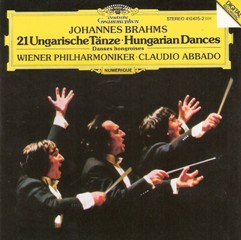111 Years of Deutsche Grammophon - CD 1
111 Years of Deutsche Grammophon - CD 1
Brahms - 21 Hungarian Dances

Hungarian Dance No.1 in G minor 1 Orchestrated by Brahms [2:53] Hungarian Dance No.2 in D minor 2 Orchestrated by Johan Andreas Hallén (1846-1925) [2:35] Hungarian Dance No.3 in F 3 Orchestrated by Brahms [2:18] Hungarian Dance No.4 in F sharp minor 4 Orchestrated by Paul Juon (1872-1940) [4:08] Hungarian Dance No.5 in G minor 5 Orchestrated by Martin Schmeling (?-1943) [2:16] Hungarian Dance No.6 in D flat 6 Orchestrated by Martin Schmeling (?-1943) [3:04] Hungarian Dance No.7 in F Hungarian Dance No. 7 in A 7 Orchestrated by Martin Schmeling (?-1943) [1:33] Hungarian Dance No.8 in A minor 8 Orchestrated by Hans Gál (1890-1987) [2:48] Hungarian Dance No.9 in E minor 9 Orchestrated by Hans Gál (1890-1987) [1:36] Hungarian Dance No.10 in F 10 Orchestrated by Brahms [1:36] Hungarian Dance No.11 in D minor 11 Orchestrated by Albert Parlow (?-1888) [2:25] Hungarian Dance No.12 in D minor 12 Orchestrated by Albert Parlow (?-1888) [2:17] Hungarian Dance No.13 in D 13 Orchestrated by Albert Parlow (?-1888) [1:35] Hungarian Dance No.14 in D minor 14 Orchestrated by Albert Parlow (?-1888) [1:32] Hungarian Dance No.15 in B flat 15 Orchestrated by Albert Parlow (?-1888) [2:40] Hungarian Dance No.16 in F minor / major 16 Orchestrated by Albert Parlow [2:16] Hungarian Dance No.17 in F sharp minor 17 Orchestrated by A. Dvorák (1841-1904) [2:45] Hungarian Dance No.18 in D 18 Orchestrated by A. Dvorák (1841-1904) [1:22] Hungarian Dance No.19 in B minor 19 Orchestrated by Antonín Dvorák [1:56] Hungarian Dance No.20 in E minor 20 Orchestrated by Antonín Dvorák [2:25] Hungarian Dance No.21 in E minor 21 Orchestrated by Antonín Dvorák [1:16] Wiener Philharmoniker Claudio Abbado – conductor
The Hungarian Dances (German: Ungarische Tänze) by Johannes Brahms (WoO 1), are a set of 21 lively dance tunes based mostly on Hungarian themes, completed in 1869.
They vary from about a minute to four minutes in length. They are among Brahms' most popular works, and were certainly the most profitable for him. Each dance has been arranged for a wide variety of instruments and ensembles. Brahms originally wrote the version for piano four-hands and later arranged the first 10 dances for solo piano.
Only numbers 11, 14 and 16 are entirely original compositions. The most famous Hungarian Dance is No. 5 in F♯ minor (G minor in the orchestral version)[citation needed], but even this dance was based on the csárdás by Kéler Béla titled "Bártfai emlék" which Brahms mistakenly thought was a traditional folksong.
Brahms wrote orchestral arrangements for No. 1, No. 3 and No. 10. Other composers have orchestrated the other dances. These composers include Antonín Dvořák, Andreas Hallén (No. 2), Paul Juon (No. 4), Martin Schmeling (Nos. 5 to 7), Hans Gál (Nos. 8 and 9), Albert Parlow (Nos. 11 to 16). Dvořák orchestrated the last numbers. More recently, Iván Fischer has orchestrated the complete set.
Brahms's Hungarian Dances were influential in the development of ragtime. See, for example, the role of German-American piano teacher Julius Weiss in ragtime composer Scott Joplin's early life and career.
Zmieniony (Piątek, 02 Marzec 2012 20:40)








